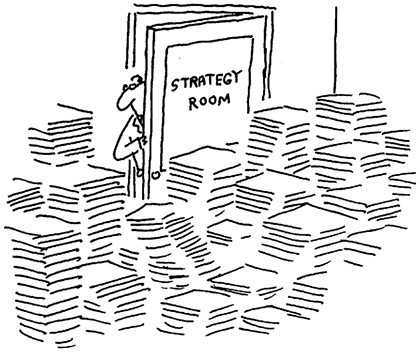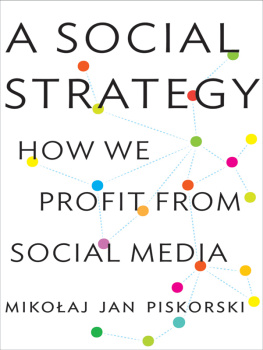Cover image: Jeremy Banks (Banx)
Cover design: Wiley
Cartoons: Mike Shapiro created signed cartoons and Jeremy Banks (Banx) created all others
Copyright 2018 by McKinsey & Company. All rights reserved.
Published by John Wiley & Sons, Inc., Hoboken, New Jersey.
Published simultaneously in Canada.
No part of this publication may be reproduced, stored in a retrieval system, or transmitted in any form or by any means, electronic, mechanical, photocopying, recording, scanning, or otherwise, except as permitted under Section 107 or 108 of the 1976 United States Copyright Act, without either the prior written permission of the Publisher, or authorization through payment of the appropriate per-copy fee to the Copyright Clearance Center, Inc., 222 Rosewood Drive, Danvers, MA 01923, (978) 750-8400, fax (978) 646-8600, or on the Web at www.copyright.com. Requests to the Publisher for permission should be addressed to the Permissions Department, John Wiley & Sons, Inc., 111 River Street, Hoboken, NJ 07030, (201) 748-6011, fax (201) 748-6008, or online at www.wiley.com/go/permissions.
Limit of Liability/Disclaimer of Warranty: While the publisher and author have used their best efforts in preparing this book, they make no representations or warranties with respect to the accuracy or completeness of the contents of this book and specifically disclaim any implied warranties of merchantability or fitness for a particular purpose. No warranty may be created or extended by sales representatives or written sales materials. The advice and strategies contained herein may not be suitable for your situation. You should consult with a professional where appropriate. Neither the publisher nor author shall be liable for any loss of profit or any other commercial damages, including but not limited to special, incidental, consequential, or other damages.
For general information on our other products and services or for technical support, please contact our Customer Care Department within the United States at (800) 762-2974, outside the United States at (317) 572-3993, or fax (317) 572-4002.
Wiley publishes in a variety of print and electronic formats and by print-on-demand. Some material included with standard print versions of this book may not be included in e-books or in print-on-demand. If this book refers to media such as a CD or DVD that is not included in the version you purchased, you may download this material at http://booksupport.wiley.com. For more information about Wiley products, visit www.wiley.com.
ISBN 978-1-119-48762-3 (Hardcover)
ISBN 978-1-119-48763-0 (ePDF)
ISBN 978-1-119-48760-9 (ePub)
To
Bini, Walter, and Hildegund Hirt
Bibi, Jan-Ferdel, and Ute Smit
Mel, Olivia, Alice, and Harriet Bradley
And to our
Partners and Colleagues at McKinsey & Company
for giving us the opportunity to beat the odds.

Introduction
Welcome to the strategy room
In the strategy room, human bias and social dynamics can prevent the necessary big moves from getting on the table, let alone getting executed. In this book we arm ourselves with hard data from thousands of companies to take the social side of strategy head on.
Isnt there another way?
We hear that all the time, and you must have asked yourself that question, tooprobably more than once. Perhaps after an exhausting marathon of strategy sessions that are supposed to be discussions but really are just presentations. Perhaps after feeling compelled to say yes to another investment proposal with uncertain prospects. Perhaps after one of the usual discussions to re-allocate resources to growth opportunities that go nowhere.
Over decades of working with hundreds of the most senior business leaders around the world, we agreed:
There has to be another way...
As interesting as these books are to read, as inspiring as their case examples are, it seems we are still short a breakthrough. Todays strategic challenges are, in fact, very similar to what theyve been over the ages, despite the serious efforts of a lot of smart people.
This book belongs on a different shelf. Rather than relying on the traditional approach of best practices and inspiring anecdotes, we use broad and deep empirical research. We have identified a small number of performance levers that, according to the factual evidence we compiledand our experience in implementing themcan be used to greatly increase your odds of success. We believe weve also found the oneoften overlookedfactor responsible for many of the conundrums facing us in the strategy room, the one factor that has perplexed generations of business leaders, the factor that causes so many strategies to not work out as planned. That factor is what we call the social side of strategy.
In this book, we use empirical insights to finally help you and other business leaders chart a course to address the social side of strategy and, as a result, develop better, bigger, bolder strategies.
There is another way!
You are not alone
As we begin our journey together through the empirics and the social side of strategy, lets peer into the strategy room and look at some of the scenes playing out there. These scenes probably feel familiar to you because they are surprisingly common despite all those books and articles about how to get to better strategy, better decisions, and better business performance.
As the strategy process starts, the team agrees that this year you will avoid huge documents with 150 slides and endless appendices. You commit to having real conversations about the future of the business and the tough choices youll have to make. Then, two days before the first meeting, three of those 150-page documents land in the CEOs in-box with a thud. So much for real conversations. You are back wading through details in carefully scripted presentations that numb the senses before anybody has a chance to fully grasp the content.

Or, you decide that you need to have a deep strategic rethink after a stretch of indifferent results. The top team agrees on a change in direction. The board approves. Then the CFO takes over and turns that vision into a first-year budget. The boldness oozes away as those who stand to lose resources mount rear-guard actions and as other immune responses to real changes kick in. Somehow, that bold rethink produces a new budget that looks a lot like last years budget. Its back to business as usual.
How about a third scenario? The strategy is agreed on. It all looks good on paper, and there is loads of compelling backup. But, somehow, deep down, everybody senses that the strategy is nothing more than hopeful thinking. It is a little too kind to the egos of the people who made it and a little too unwilling to embrace the harsh reality of competition. People two or three levels down in the organizationthe ones who engage with actual customers, the ones who often werent really part of the strategy processconclude that management is stuck in a bubble, roll their eyes, and just get on with what they were doing. All that new strategy ends up being good for is justifying some uneconomic projectsthe ones labeled strategic because they lose money; everybody knows that no real change in trajectory will happen because of them.
Even if you are the CEO, it can feel at times as if the inertia caused by individual behaviors and social dynamics is rather hard to deal withand getting in the way of doing the right thing for your business. One of our client CEOs in Australia recently reflected: I am well aware of the fact that we should be moving faster in that direction, but I have to bring the team along.
Next page












